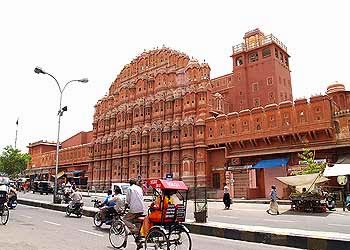Hawa Mahal - Jaipur, Rajastan
Hawa Mahal is a palace in Jaipur, India, so named because it was essentially a high screen wall built so the women of the royal household could observe street festivities while unseen from the outside. Constructed of red and pink sandstone, the palace sits on the edge of the City Palace, and extends to the zenana, or women's chambers.
The structure was built in 1799 by Maharaja Sawai Pratap Singh, and designed by Lal Chand Ustad in the form of the crown of Krishna, the Hindu god. Its unique five-storey exterior is akin to the honeycomb of a beehive with its 953 small windows called jharokhas decorated with intricate latticework.The original intention of the lattice was to allow royal ladies to observe everyday life in the street below without being seen, since they had to obey strict "purdah" (face cover). The lattice also allows cool air from the Venturi effect (doctor breeze) through the intricate pattern, air conditioning the whole area during the high temperatures in summers.In 2006, restoration and renovation works on the Mahal were undertaken, after a gap of 50 years, to give a face lift to the monument at an estimated cost of Rs 4568 million.The corporate sector lent a hand to preserve the historical monuments of Jaipur and the Unit Trust of India has adopted Hawa Mahal to maintain it.
The palace is a five-storey pyramidal shaped monument that rises 50 feet (15 m) from its high base. The top three floors of the structure have a dimension of one room width while the first and second floors have patios in front of them. The front elevation, as seen from the street, is like a honeycomb web of a beehive, built with small portholes. Each porthole has miniature windows and carved sandstone grills, finials and domes. It gives the appearance of a mass of semi-octagonal bays, giving the monument its unique façade. The inner face on the back side of the building consists of need-based chambers built with pillars and corridors with minimal ornamentation, and reach up to the top floor. The interior of the Mahal has been described as "having rooms of different coloured marbles, relieved by inlaid panels or gilding; while fountains adorn the centre of the courtyard".
Lal Chand Ustad was the architect of this unique structure who also planned Jaipur city, considered then as one of the best-planned cities in India. Built in red and pink coloured sand stone, in keeping with the décor of the other monuments in the city, its colour is a full testimony to the epithet of "Pink City" given to Jaipur. Its façade depicts 953 inches with intricately carved jharokhas (some are made of wood) is a stark contrast to the plain looking rear side of the structure. Its cultural and architectural heritage is a true reflection of a fusion of Hindu Rajput architecture and the Islamic Mughal architecture; the Rajput style is seen in the form of domed canopies, fluted pillars, lotus and floral patterns, and the Islamic style as evident in its stone inlay filigree work and arches (as distinguished from its similarity with the Panch Mahal - the palace of winds - at Fatehpur Sikri).
The entry to the Hawa Mahal from the city palace side is through an imperial door. It opens into a large courtyard, which has double storeyed buildings on three sides, with the Hawa Mahal enclosing it on the east side. An archaeological museum is also housed in this courtyard.Hawa Mahal was also known as the chef-d'œuvre of Maharaja Jai Singh as it was his favourite resort because of the elegance and built-in interior of the Mahal. The cooling effect in the chambers, provided by the breeze passing through the small windows of the façade, was enhanced by the fountains provided at the centre of each of the chambers.The top two floors of the Hawa Mahal are accessed only through ramps. The Mahal is maintained by the archaeological Department of the Government of Rajasthan.
booking
Use Special Coupon Code "VBSP15"
----------------------------------------------------------------------------------------------------------------------------------
Get A cheapest bus ticket from www.vishvabhraman.com and get upto 15% discount on all bus
booking
Use Special Coupon Code "VBSP15"




No comments:
Post a Comment
Note: only a member of this blog may post a comment.